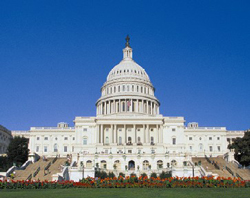Federal Government Oversight
Created by laws or by executive order, several federal departments and agencies have legal authority to regulate various aspects of the natural gas industry. Periodically, Congress reviews those departments and agencies and passes new laws changing their programs and authorities. For example, in 1989 Congress passed a law removing the Federal Energy Regulatory Commission’s authority to regulate the price of natural gas at the wellhead. In 1990, Congress passed the ‘Clean Air Act’, giving the Environmental Protection Agency greater authority to reduce air pollution and regulate air emissions from cars, factories, and electric generators. Both of these laws have had a major impact on the natural gas industry.
Click on the links below to learn more about the specific duties and jurisdictions of the various congressional committees, as well as information on current issues and pending legislation that may affect the natural gas industry:
U.S. House of Representatives:
- The Committee on Energy and Commerce – This committee has jurisdiction over the Department of Energy, including the Federal Energy Regulatory Commission, and the Environmental Protection Agency
- The Committee on Resources – This committee has jurisdiction over the Department of the Interior, including the Bureau of Land Management and the Minerals Management Service
- The Ways and Means Committee – This committee has jurisdiction over the Treasury Department, including federal taxation of the natural gas industry
U.S. Senate:
- The Committee on Energy and Natural Resources – This committee has jurisdiction over the Department of Energy, including the Federal Energy Regulatory Commission, and the Department of the Interior, including the Bureau of Land Management and the Minerals Management Service
- The Committee on Environment and Public Works – This committee has jurisdiction over the Environmental Protection Agency
- The Finance Committee – This committee has jurisdiction over the Treasury Department, including federal taxation of the natural gas industry
Federal Departments and Agencies:
There are a number of departments and agencies created by law or executive order, which have jurisdiction over certain aspects of the natural gas industry. To learn more about these departments and agencies, their mission, programs, authority, and current issues, click on the links below:
- The Department of Energy (DOE)
“The priorities of the Department’s energy program are to: increase domestic energy production; revolutionize our approach energy conservation and efficiency; and promote the development of renewable and alternative energy sources.” - The Federal Energy Regulatory Commission (FERC)
“The Federal Energy Regulatory Commission regulates and oversees energy industries in the economic and environmental interest of the American public.” - The Environmental Protection Agency (EPA)
“EPA’s mission is to protect human health and to safeguard the natural environment – air, water, and land – upon which life depends.” - The Department of the Interior (DOI)
“DOI’s mission is to protect and provide access to our Nation’s natural and cultural heritage and honor our trust responsibilities to Indian tribes and our commitments to island communities.”- The Bureau of Land Management (BLM)
“BLM’s mission is to sustain the health, diversity, and productivity of the public lands for the use and enjoyment of present and future generations. - The Minerals Management Service (MMS)
“The mission of MMS is to manage the mineral resources on the Outer Continental Shelf in an environmentally sound and safe manner and to timely collect, verify and distribute mineral revues from federal and Indian lands.”
- The Bureau of Land Management (BLM)
- The Treasury Department
“The mission of the Department of the Treasury is to promote prosperous and Stable American and World Economies and Manage the Government’s Finances.” - The Department of Transportation (DOT)
“The mission of the Department of Transportation is to serve the United States by ensuring a fast, safe, efficient, accessible and convenient transportation system that meets our vital national interests and enhances the quality of life of the American people, today and into the future.”- The Office of Pipeline Safety (OPS)
“The mission of OPS is to ensure the safe, reliable and environmentally sound operation of the nation’s pipeline transportation system.”
- The Office of Pipeline Safety (OPS)
